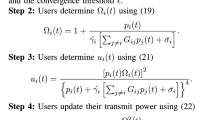Abstract
Controlling the distribution of resources is imperative in any wireless system. Much research has considered the efficiency of the allocation in terms of bits per Joule of radiated energy. The most common model used in analysis of this utility has been the logistic curve. Many game theoretical concepts have been used to propose algorithms that help such systems reach an optimal operating point. This paper investigates network assisted power control in general and, unlike other work that has previously been done, proves that for a very general class of functions it is Pareto Optimal. Furthermore, a methodology to modeling wireless systems with various modulation and channel conditions as logistic functions is presented and their trade-offs investigated.






Similar content being viewed by others
References
Alyfantis, G., Hadjiefthymiades, S., & Merakos, L. (2006). On fair and efficient power control in cdma wireless data networks. In Proceedings 15th international conference on computer communications and networks 2006, (pp. 309–314).
Bacci, G., Sanguinetti, L., & Luise, M. (2015). Understanding game theory via wireless power control [lecture notes]. Signal Processing Magazine, IEEE, 32(4), 132–137.
Boche, H., & Schubert, M. (2009). Nash bargaining and proportional fairness for wireless systems. IEEE/ACM Transactions on Networking, 17(5), 1453–1466.
Boche, H., & Schubert, M. (2011). A generalization of nash bargaining and proportional fairness to log-convex utility sets with power constraints. IEEE Transactions on Information Theory, 57(6), 3390–3404.
Cabella, B. C. T., Martinez, A. S., & Ribeiro, F. (2011). Data collapse, scaling functions, and analytical solutions of generalized growth models. Mathematical Biosciences, 83(6), 061902.
Feng, N., Mau, S.-C., & Mandayam, N. B. (2004). Pricing and power control for joint user-centric and network-centric resource allocation. IEEE Transactions on Communications, 52(9), 1547–1557.
Goodman, D. J., & Mandayam, N. B. (2001). Network assisted power control for wireless data. Mobile Networks and Applications, 6(5), 409–415.
Goodman, D. J., Marantz, Z., Orenstein, P., & Rodriguez, V. (2003). Maximizing the throughput of CDMA data communications. In IEEE 58th vehicular technology conference (VTC).
Han, Z., & Liu, K. J. R. (2008). Resource allocation for wireless networks: Basics, techniques, and applications. Cambridge: Cambridge University Press.
Han, Z., Niyato, D., Saad, W., Başar, T., & Hjørungnes, A. (2011). Game theory in wireless and communication networks: Theory, models, and applications. Cambridge: Cambridge University Press.
Kim, S.-M., Moon, J.-I., Cho, I.-K., Yoon, J.-H., Byun, Woo-Jin, & Choi, H.-C. (2015). Advanced power control scheme in wireless power transmission for human protection from em field. IEEE Transactions on Microwave Theory and Techniques, 63(3), 847–856.
Leung, K. K., Sung, C. W., Wong, W. S., & Lok, T. M. (2004). Convergence theorem for a general class of power-control algorithms. IEEE Transactions on Communications, 52(9), 1566–1574. doi:10.1109/TCOMM.2004.833140.
Marantz, Z. (2006). Efficient power allocation in wireless networks. PhD thesis, Polytechnic University.
Marantz, Z. (2013). On the optimality of network assisted power control for a general class of sigmoid functions. Wireless Telecommunications Symposium (WTS), 2013, 1–5.
Marantz, Z., Orenstein, P., & Goodman, D. (2005). Admission control for maximal throughput in power limited CDMA systems. In Wireless communications and netwroking conference (WCNC), New Orleans, LA.
Marantz, Z., Orenstein, P., & Goodman, D. (2011). A power control based admission algorithm for maximizing throughput in a cdma network. Wireless Personal Communications, 59, 741–764.
Meshkati, F., Poor, H. V., Schwartz, S. C., & Balan, R. V. (2009). Energy-efficient resource allocation in wireless networks with quality-of-service constraints. Transactions on Communications, 57(11), 3406–3414.
Meyer, P. S., Yung, J. W., & Ausubel, J. H. (1999). A primer on logistic growth and substitution: The mathematics of the loglet lab software. Technological Forecasting and Social Change, 61, 247–271.
Rodriguez, V. (2002). Maximizing a sigmoid with respect to its argument. WICAT Tech. Rep. 02-010, Polytechnic University.
Rodriguez, V. (2003). An analytical foundation for resource management in wireless communication. In GlobeCom, 2003.
Rodriguez, V., & Goodman, D. J. (2002). Improving a utility function for wireless data. WICAT Tech. Rep. 02-009, Polytechnic University.
Saraydar, C. U. (2001). Pricing and power control in wireless data networks. PhD thesis, Rutgers University, New Brunswick, New Jersey.
Saraydar, C. U., Mandayam, N. B., & Goodman, D. J. (2002). Efficient power control via pricing in wireless data networks. IEEE Transactions on Communications, 50(2), 291–303. doi:10.1109/26.983324.
Shah, V., Mandayam, N. B., & Goodman, D. J. (1998). Power control for wireless data based on utiulity and pricing. WINLAB Tech. Rep. WINLAB-TR-159, Rutgers University.
Stoll, Manfred. (2001). Introduction to Real Analysis. Reading, MA: Addison-Wesley.
Struzak, R. (2012). Diffusion of broadband services: An empirical study. Communications Magazine, IEEE, 50(8), 128–134.
Sung, C. W., & Wong, W. S. (2001). Power control and rate management for wireless multimedia CDMA systems. IEEE Transactions on Communications, 49(7), 1215–1226. doi:10.1109/26.935162.
Tang, X., Ren, P., Wang, Y., Du, Q., & Sun, L. (2014). Efficient power control via non-cooperative target sinr competition in distributed wireless networks. In 2014 IEEE 80th vehicular technology conference (VTC Fall), (pp. 1–5).
Tao, J., & Deyong, G. (2012). Study of logistic growth curve model for mobile user growth. In 2012 3rd international conference on system science, engineering design and manufacturing informatization (ICSEM), (vol. 2, pp. 188–192).
Tsoularis, A. (2001). Analysis of logistic growth models. Research letters in the information and mathematical sciences, 2, 23–46.
Yaïche, H., Mazumdar, R. R., & Rosenberg, C. (2000). A game theoretic framework for bandwidth allocation and pricing in broadband networks. IEEE/ACM Transactions on Networking, 8(5), 667–678. doi:10.1109/90.879352.
Author information
Authors and Affiliations
Corresponding author
Additional information
This work was supported in part by NSF Grant No. 0219822, PSC-CUNY Grant No. PSCOOC-39-145, and PSCREG-40-547. Various contents of this paper have been presented in Wireless Telecommunications Symposium (WTS) 2013.
Rights and permissions
About this article
Cite this article
Marantz, Z. Logistic Modeling for Optimal Resource Allocation in Network Assisted Power Control. Wireless Pers Commun 90, 281–299 (2016). https://doi.org/10.1007/s11277-016-3345-2
Published:
Issue Date:
DOI: https://doi.org/10.1007/s11277-016-3345-2




